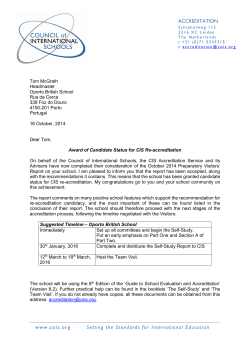
QUALITY ASSURANCE SYSTEM IN EDUCATION: A COUNTRY
The Role of the National Authority for Quality Assurance and Accreditation (NAQAAE) in Egyptian Education The National Authority for Quality Assurance and Accreditation of Education, Egypt www.Naqaae.org.eg Background NAQAAE is the accrediting body for all Egyptian educational institutions (higher education, pre- university, and Al-Azhar education) (about 55,000) NAQAAE was established in 2007 by a Presidential Decree. The Board is formed of a President, three Vice- Presidents and eleven board members selected from educational experts, businessmen and entrepreneurs The main goal is to support Egyptian educational institutes by fostering their quality assurance practices 2 “An internationally recognized accrediting body, known for its fair and objective decisions, its leadership in quality assurance, and excellence at national, regional and international levels, while maintaining its Egyptian identity” 3 “To assure the quality of education institutions, continuous improvement and efficient performance consistent with their mission statement and objectives, as well as insuring public independent, confidence impartial and through transparent operations” 4 Objectives To raise awareness of educational quality assurance among the Egyptian Academic Institutes and the Egyptian Society To establish an integrated system for accreditation To set up educational assessment indicators. standards and performance To support the Egyptian Educational Institutions in their preparation of self assessment To assert confidence and establish accountability in the educational outcomes 5 18 G. Universities ( 325 faculties) Al-Azhar University (68 faculties) 18 Private Universities (72 faculties) Higher education institutes (100) 4 million students Responds to global changes. Reflects the country’s development plans, market needs and employment expectation. Co-operation with regional and international agenesis to reach a mutual recognition. Cooperation with the stakeholders to set the standards of accreditation. Acknowledgment of academic freedom. Provides impartial technical support without interfering with institutional QA process. Evaluation is based on assessment of learning outcomes. Accountability Student- centered education Learning rather than Teaching Academic Integrity Career guidance Life long learning and learning how to learn Feed back – based improvement Outcome- based assessment Continues reviewing of programs and courses Innovation in teaching and learning strategies Imbedding Entrepreneurship and commercialization of knowledge in programs and courses Alignment of: graduate attributes - academic standards- learning objectives and outcomes teaching and learning - student assessment Phase I: Setting the standards of accreditation and education improvement in cooperation with stakeholders (1 year) Phase II: Provide the technical support for educational Institutions (continuous) Phase III: Accrediting Educational Institutions (continuous) 10 Institutional accreditation (Faculties) University accreditation Accreditation Program accreditation E. Learning programs accreditation Pre- university education Institutional Assessment (school): Institutional Capacity 1. Vision & mission 2. Governance 3. Human & Financial Resource 4. Community Participation 5. QA & Accountability Educational Effectiveness 1. 2. 3. 4. Student achievements Teacher qualifications Academic Curriculum Educational Environment “ Higher education Institutional Assessment (Faculties): Institutional Capacity: 1. Strategic Planning 2. Organizational Structure 3. Leadership &Governance 4. Creditability & Ethics 5. Administration. 6. Resources 7. Community Participation 8. Quality systems management. hhhh Educational Effectiveness: 1. Students & Graduates. 2. Academic Standards. 3. Educational Program. 4. Teaching, Learning, & Resources. 5. Academic Staff. 6. Scientific Research . 7. Post-Graduate Studies. 8. Continuous Assessment. 12 Outcome based assessment. Based on evaluating two main areas: - Program management - Educational effectiveness Program : Program management 1. Mission and objectives 2. Leadership 3. Financial & physical resources Educational Effectiveness 1. Program Structure 2. Teaching and Learning 3. Academic Staff 4. Assessment of Learning Outcomes 5. Program Development & Enhancement 6. Indicators of Success “ E. Learning program : Institutional Capacity: 1. Program management 2. Human, financial & physical resources Educational Effectiveness: 1. Program structure 2. Teaching and learning 3. Students 4. Self- assessment and continuous development 14 Strategic planning Governing policies & its impact Performance assessment and sustainable development To ensure: Sustainable development Improvement of Universities ranking National Academic Reference Standards (NARS): Describes the minimum requirements to accomplish a certain program. It includes graduate attributes and characterizes knowledge and understanding, as well as professional, intellectual and transferable skills NORMS: Resources (human, library, teaching facilities & physical resources) Code of practice (accreditation standards) 1 2 3 • Reforming Educational Programs and courses • Determining the Intended Learning Outcomes • Improving graduates competencies and competitiveness 17 1 • Improving institutional capacity and educational practices 2 • Improving the Internal Quality System 3 • Accreditation 18 Pre-accreditation phase (Technical support) by NAQAAE’s team Towards Accreditation Accreditation phase by NAQAAE’s reviewers An optional process for gap analysis Simulate and encourage the accreditation visit. Confidential report No decision Gap analysis Self-study report Improvement plan NAQAAE Decision Sending the report to the institution for feedback Report draft Institution self-study Reviewing team (4 reviewers ) Institution visit (3-5 days) Accredited: When the institute fulfills most of the standards of accreditation. Not – Accredited: When the institute doesn’t fulfill most of the standards of accreditation. Postponed: When it doesn’t fulfill some of the standards of accreditation (except Educational effectiveness standards ). NAQAAE have channels of communications with national, regional and international accreditation entities: Mutual recognition / alliance with ABET, JABEE Cooperation with QAA (UK) and SQA Acquiring membership of Arab, African and international networks for external reviewing and accrediting agencies 24 Thank you Questions? 27
© Copyright 2025




![National University Virtual High School [2014-2015]](http://cdn1.abcdocz.com/store/data/000348438_1-3a80ae3134ab49395c6a7578fe5bdf0b-250x500.png)
















